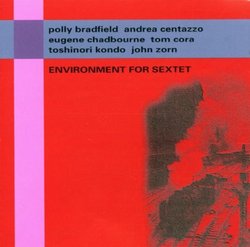A document of a previous era.
Michael Stack | North Chelmsford, MA USA | 02/26/2008
(4 out of 5 stars)
"One of the few surviving non-Game Piece documents of the early downtown New York music scene, "Environment for Sextet", recorded November of 1978, presents six of the musicians associated with that early scene-- Polly Bradfield on violin, Andrea Centazzo on percussion, Eugene Chadbourne on guitars, Tom Cora on cello, Toshinori Kondo on trumpet and John Zorn on various reeds-- in what sounds to me to be a structured improvisation.
I find this record somewhat hard to describe in detail, so instead I'll give a sort of impression-- here are six young musicians just starting to come into their own. It's interesting hearing the ideas and the energies bubbling forth from them and (at least in the case of Chadbourne, Kondo and Zorn, whose later work I'm quite familiar with), seeing how these very humble beginnings led to something entirely other. The pieces in general tend to have an oddly lurching quality to them, occasionally bubbling to a more aggressive timber as someone (usually one of the horns) lets go a bit of skronk that inspires the rest.
It's not really a recording I find myself returning to frequently, but as a document of this time (of which largely only Zorn's Game Pieces are widely available), it proves quite intriguing. Hearing them perform without Zorn's structure in place provides an opportunity for a more personal expression akin to Zorn's improv sessions (documented heavily in the birthday concert series). This analogy is particularly accurate with bonus track "Improvviso III", a duet between Zorn and Centazzo when many elements of Zorn's language are already becoming clear and the piece boils in the same sort of way that his later duets with, for example, Milford Graves do. For fans of John Zorn, et.al., this is a unique document. Recommended."


 Track Listings (5) - Disc #1
Track Listings (5) - Disc #1